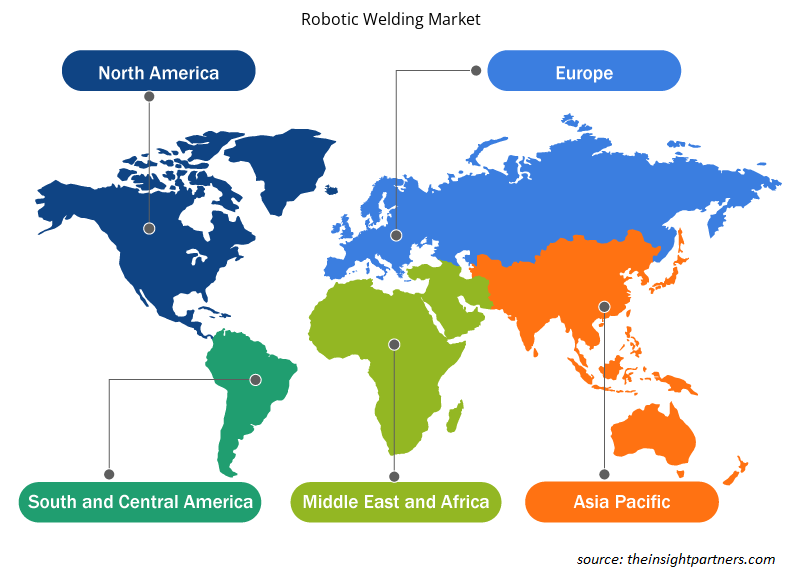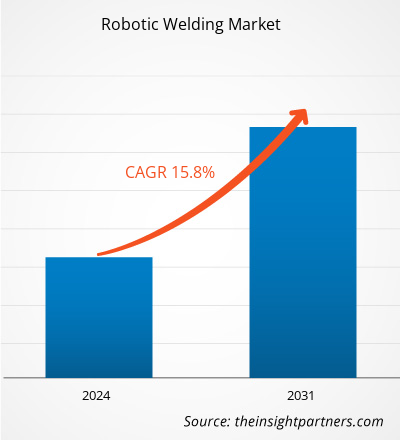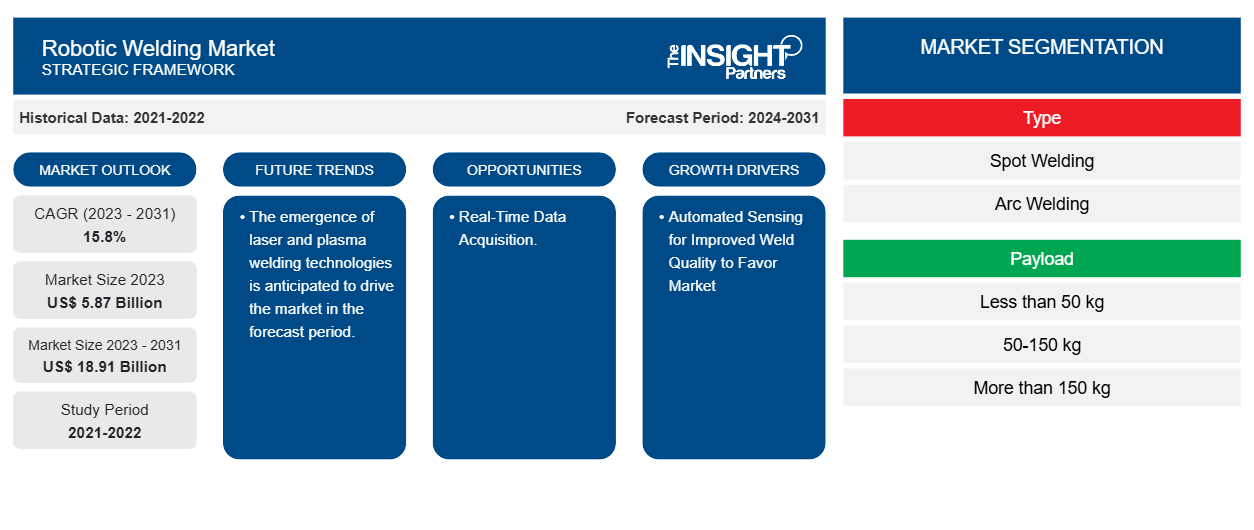من المتوقع أن يصل حجم سوق اللحام الآلي إلى 18.91 مليار دولار أمريكي بحلول عام 2031 من 5.87 مليار دولار أمريكي في عام 2023. ومن المتوقع أن يسجل السوق معدل نمو سنوي مركب بنسبة 15.8٪ خلال الفترة 2023-2031. ومن المرجح أن يكون الطلب على الروبوتات الصناعية وزيادة اعتماد روبوتات اللحام في صناعات السيارات من المحركات والاتجاهات الرئيسية للسوق.
تحليل سوق اللحام الآلي
يشهد سوق اللحام الآلي نموًا كبيرًا على مستوى العالم. ويعزى هذا النمو إلى الثورة الصناعية الرابعة لدفع الطلب على الروبوتات الصناعية والاعتماد المتزايد على روبوتات اللحام في صناعات السيارات. علاوة على ذلك، تعد المبادرات الحكومية لدعم التحول الرقمي في منطقة آسيا والمحيط الهادئ وظهور تقنيات اللحام بالليزر والبلازما من بين العوامل الأخرى التي تدعم نمو سوق اللحام الآلي.
نظرة عامة على سوق اللحام الآلي
اللحام الآلي هو أسلوب يساعد القطاع الصناعي على أتمتة عملياته وزيادة الدقة وتقليل وقت التنفيذ وتعزيز السلامة. تعتبر عملية اللحام الآلي هي الأعلى إنتاجية عندما يتم تنفيذها لمهام متكررة ذات حجم كبير. هناك أنواع متعددة من عمليات اللحام الآلي.
قم بتخصيص هذا التقرير ليناسب متطلباتك
ستحصل على تخصيص لأي تقرير - مجانًا - بما في ذلك أجزاء من هذا التقرير، أو تحليل على مستوى الدولة، وحزمة بيانات Excel، بالإضافة إلى الاستفادة من العروض والخصومات الرائعة للشركات الناشئة والجامعات
-
احصل على أهم اتجاهات السوق الرئيسية لهذا التقرير.ستتضمن هذه العينة المجانية تحليلاً للبيانات، بدءًا من اتجاهات السوق وحتى التقديرات والتوقعات.
محركات وفرص سوق اللحام الآلي
الاستشعار الآلي لتحسين جودة اللحام لصالح السوق
تسمح تقنيات الاستشعار الآلية للروبوتات اللحامية بتبني العمليات وفقًا لأبعاد قطعة العمل الفردية. وهذا يعمل على تحسين جودة كل لحام مع زيادة سرعة العمليات، ونتيجة لذلك، يوفر إنتاجية أعلى. يساعد تضمين هذه التقنيات في كل خلية لحام على مراقبة عملية اللحام وتسجيل التفاصيل لتحسين العملية المستمرة، وضبط معلمات روبوت اللحام تلقائيًا وفقًا لقطعة العمل ومراقبة عملية اللحام وتسجيل التفاصيل لتحسين العملية المستمرة.
الحصول على البيانات في الوقت الحقيقي
إلى جانب الاستشعار الآلي، يتقدم اكتساب البيانات التشغيلية وتحليلها لأنظمة اللحام الآلية بسرعة كبيرة. ونظرًا لأن كل لحام يحتاج إلى فحص محدد لتأهيل عملية مراقبة الجودة، فإن هذه الأدوات تجعل من الممكن إثبات قوة الوصلة، وختم كل خط، واختراق اللحام أثناء عملية اللحام.
تستطيع أنظمة التحكم في تتبع القوس تحديد الأخطاء تلقائيًا وتصحيح عملية اللحام لتقليل إعادة العمل التي تظهر عادةً فقط أثناء الفحص الثانوي. بالإضافة إلى ذلك، توفر هذه الأنظمة قياس عرض المفصل والملف أثناء عملية اللحام، واكتشاف حافة المفصل، وتتبع اختراق اللحامات أثناء اللحامات، والتحكم في اختراق اللحام وفقًا للمواصفات.
تقرير تحليل تجزئة سوق اللحام الآلي
إن القطاعات الرئيسية التي ساهمت في اشتقاق تحليل سوق اللحام الآلي هي النوع والحمولة والمستخدم النهائي.
- وفقًا للنوع، يتم تقسيم سوق اللحام الآلي إلى اللحام النقطي واللحام القوسي وغيرها. ومن المتوقع أن يحظى قطاع مكونات إدارة الطاقة بحصة سوقية كبيرة خلال فترة التوقعات.
- بناءً على الحمولة، يتم تقسيم سوق اللحام الآلي إلى أقل من 50 كجم، و50-150 كجم، وأكثر من 150 كجم. ومن المتوقع أن تحظى شريحة أقل من 50 كجم بحصة سوقية كبيرة في فترة التوقعات.
- من حيث المستخدم النهائي، يتم تقسيم السوق إلى السيارات والنقل، والكهرباء والإلكترونيات، والمعادن والآلات، والبناء. ومن المتوقع أن تحتل السيارات والنقل حصة كبيرة في السوق خلال الفترة المتوقعة.
تحليل حصة سوق اللحام الآلي حسب المنطقة الجغرافية
ينقسم النطاق الجغرافي لتقرير سوق اللحام الآلي بشكل أساسي إلى خمس مناطق: أمريكا الشمالية، ومنطقة آسيا والمحيط الهادئ، وأوروبا، والشرق الأوسط وأفريقيا، وأمريكا الجنوبية والوسطى.
سيطرت أمريكا الشمالية على سوق اللحام الآلي. وقد أدت اتجاهات تبني التكنولوجيا العالية في مختلف الصناعات في منطقة أمريكا الشمالية إلى تغذية نمو سوق اللحام الآلي. ومن المتوقع أن تؤدي عوامل مثل زيادة اعتماد الأدوات الرقمية والإنفاق التكنولوجي المرتفع من قبل الوكالات الحكومية إلى دفع نمو سوق اللحام الآلي في أمريكا الشمالية. علاوة على ذلك، فإن التركيز القوي على البحث والتطوير في الاقتصادات المتقدمة في الولايات المتحدة وكندا يجبر اللاعبين في أمريكا الشمالية على جلب حلول متقدمة تقنيًا إلى السوق. بالإضافة إلى ذلك، يوجد في الولايات المتحدة عدد كبير من اللاعبين في سوق اللحام الآلي الذين يركزون بشكل متزايد على تطوير حلول مبتكرة. كل هذه العوامل تساهم في نمو سوق اللحام الآلي في المنطقة.
رؤى إقليمية حول سوق اللحام الآلي
لقد قام المحللون في Insight Partners بشرح الاتجاهات والعوامل الإقليمية المؤثرة على سوق اللحام الآلي طوال فترة التوقعات بشكل شامل. يناقش هذا القسم أيضًا قطاعات سوق اللحام الآلي والجغرافيا في جميع أنحاء أمريكا الشمالية وأوروبا ومنطقة آسيا والمحيط الهادئ والشرق الأوسط وأفريقيا وأمريكا الجنوبية والوسطى.

- احصل على البيانات الإقليمية المحددة لسوق اللحام الآلي
نطاق تقرير سوق اللحام الآلي
| سمة التقرير | تفاصيل |
|---|---|
| حجم السوق في عام 2023 | 5.87 مليار دولار أمريكي |
| حجم السوق بحلول عام 2031 | 18.91 مليار دولار أمريكي |
| معدل النمو السنوي المركب العالمي (2023 - 2031) | 15.8% |
| البيانات التاريخية | 2021-2022 |
| فترة التنبؤ | 2024-2031 |
| القطاعات المغطاة |
حسب النوع
|
| المناطق والدول المغطاة |
أمريكا الشمالية
|
| قادة السوق وملفات تعريف الشركات الرئيسية |
|
كثافة اللاعبين في سوق اللحام الآلي: فهم تأثيرها على ديناميكيات الأعمال
يشهد سوق اللحام الآلي نموًا سريعًا، مدفوعًا بالطلب المتزايد من المستخدم النهائي بسبب عوامل مثل تفضيلات المستهلكين المتطورة والتقدم التكنولوجي والوعي المتزايد بفوائد المنتج. ومع ارتفاع الطلب، تعمل الشركات على توسيع عروضها والابتكار لتلبية احتياجات المستهلكين والاستفادة من الاتجاهات الناشئة، مما يؤدي إلى زيادة نمو السوق.
تشير كثافة اللاعبين في السوق إلى توزيع الشركات أو المؤسسات العاملة في سوق أو صناعة معينة. وهي تشير إلى عدد المنافسين (اللاعبين في السوق) الموجودين في مساحة سوق معينة نسبة إلى حجمها أو قيمتها السوقية الإجمالية.
الشركات الرئيسية العاملة في سوق اللحام الآلي هي:
- شركة باناسونيك
- شركة ياسكاوا للكهرباء
- أي بي بي
- شركة فانوك
- نظام الروبوتات IGM
- شركة كاواساكي للصناعات الثقيلة المحدودة
إخلاء المسؤولية : الشركات المذكورة أعلاه ليست مرتبة بأي ترتيب معين.

- احصل على نظرة عامة على أهم اللاعبين الرئيسيين في سوق اللحام الآلي
أخبار سوق اللحام الآلي والتطورات الأخيرة
يتم تقييم سوق اللحام الآلي من خلال جمع البيانات النوعية والكمية بعد البحث الأولي والثانوي، والتي تتضمن منشورات الشركات المهمة وبيانات الجمعيات وقواعد البيانات. فيما يلي بعض التطورات في سوق اللحام الآلي:
- أطلقت شركة Kemppi آلة لحام آلية جديدة، وهي AX MIG Welder. نقدم لكم آلة اللحام الآلية Kemppi AX MIG Welder - وهي آلة لحام آلية قوية تتميز بالتكامل السلس وواجهة سهلة الاستخدام وأحدث تقنيات اللحام. تم تصميم آلة اللحام الآلية AX MIG Welder خصيصًا لبيئات اللحام الآلية عالية الكثافة على مدار الساعة طوال أيام الأسبوع. مع طاقة 400 أو 500 أمبير ومغذي أسلاك آلي، تم تصميمها لأداء المهام الصعبة وتلبية أهداف الإنتاج الصعبة. (المصدر: موقع شركة Kemppi على الويب، أبريل 2023)
- أعلنت شركة NS ARC، أكبر علامة تجارية متخصصة في أسلاك اللحام مملوكة للنساء في الولايات المتحدة، وشركة CLOOS North America، الرائدة في تكنولوجيا اللحام الآلي والتي تتمتع بخبرة تزيد عن 100 عام في الصناعة، بفخر عن تحالفهما الاستراتيجي. (المصدر: موقع شركة NS ARC على الويب، يوليو 2024)
تقرير سوق اللحام الآلي والتغطية والنتائج المتوقعة
يوفر تقرير "حجم سوق اللحام الآلي والتوقعات (2021-2031)" تحليلاً مفصلاً للسوق يغطي المجالات التالية:
- حجم سوق اللحام الآلي وتوقعاته على المستويات العالمية والإقليمية والوطنية لجميع قطاعات السوق الرئيسية المشمولة بالنطاق.
- اتجاهات سوق اللحام الآلي بالإضافة إلى ديناميكيات السوق مثل المحركات والقيود والفرص الرئيسية.
- تحليل مفصل لقوى PEST/Porter الخمس و SWOT.
- تحليل سوق اللحام الآلي يغطي اتجاهات السوق الرئيسية والإطار العالمي والإقليمي واللاعبين الرئيسيين واللوائح والتطورات الأخيرة في السوق.
- تحليل المشهد الصناعي والمنافسة الذي يغطي تركيز السوق، وتحليل خريطة الحرارة، واللاعبين البارزين، والتطورات الأخيرة في سوق اللحام الآلي.
- ملفات تعريفية مفصلة للشركة.
- التحليل التاريخي (سنتان)، سنة الأساس، التوقعات (7 سنوات) مع معدل النمو السنوي المركب
- تحليل PEST و SWOT
- حجم السوق والقيمة / الحجم - عالمي، إقليمي، بلد
- الصناعة والمنافسة
- مجموعة بيانات إكسل
التقارير الحديثة
شهادات العملاء
سبب الشراء
- اتخاذ قرارات مدروسة
- فهم ديناميكيات السوق
- تحليل المنافسة
- رؤى العملاء
- توقعات السوق
- تخفيف المخاطر
- التخطيط الاستراتيجي
- مبررات الاستثمار
- تحديد الأسواق الناشئة
- تحسين استراتيجيات التسويق
- تعزيز الكفاءة التشغيلية
- مواكبة التوجهات التنظيمية























 احصل على عينة مجانية ل - سوق اللحام الآلي
احصل على عينة مجانية ل - سوق اللحام الآلي